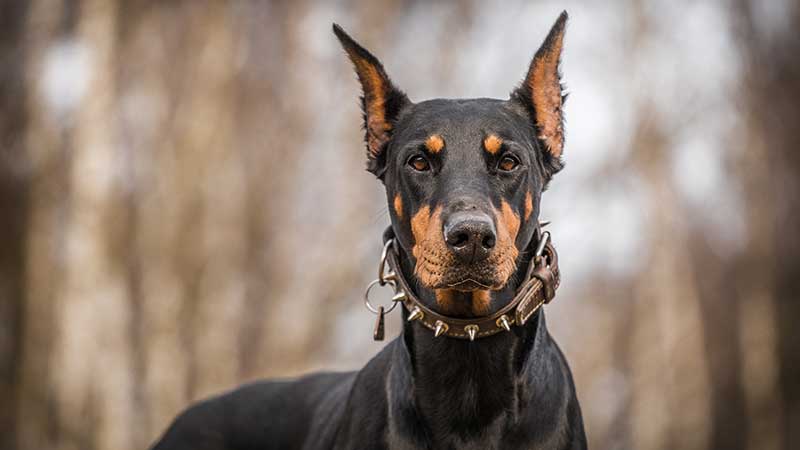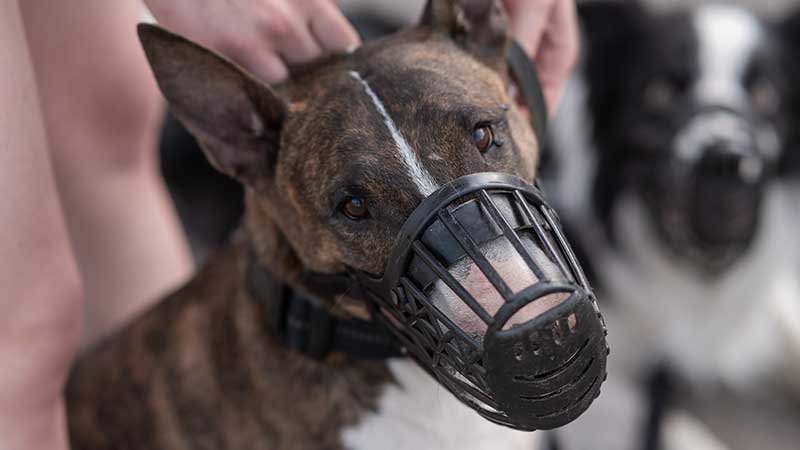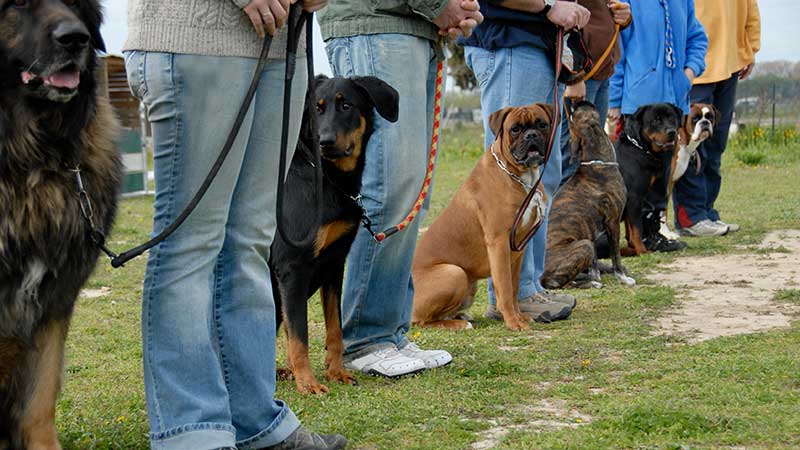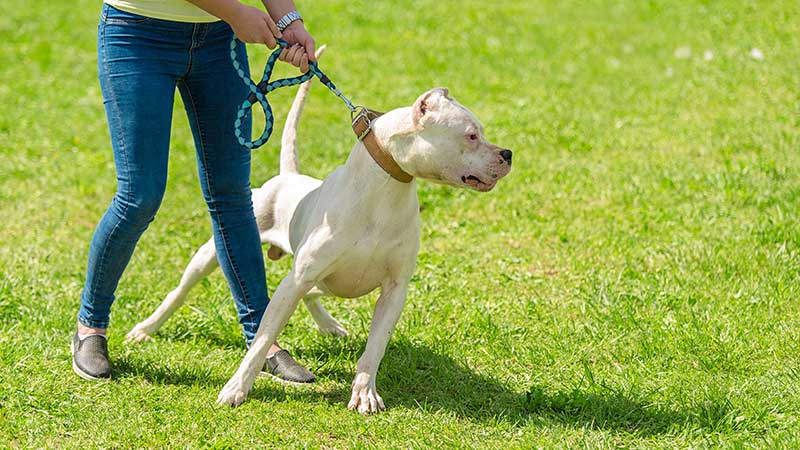For many, our four-legged companions are more than just pets; they’re a cherished part of the family.
Yet, even as the bond between humans and dogs grows stronger, there’s an aspect of dog ownership that often takes new pet parents by surprise: the dog breeds insurance blacklist. At its core, this blacklist–a strong but common term–is a list of specific dog breeds deemed by some insurance companies to pose a higher risk, leading to potential insurance restrictions or premium increases.
It’s essential for homeowners to be well-acquainted with this concept. Whether you’re a longtime dog owner or considering adopting a new furry friend, understanding the dog breeds insurance blacklist can play a crucial role in navigating homeowner’s insurance policies.
Such knowledge ensures that homeowners can make informed decisions, safeguard their interests, and provide a loving, secure home for their pets.
The History Behind the Dog Breeds Insurance Blacklist

Understanding the dog breeds insurance blacklist requires a journey back in time.
How did we reach a point where certain canine companions are labeled as high-risk based on their breed alone?
The Origin of Breed Bias
The categorization of certain dog breeds as dangerous can be traced back to a few high-profile incidents.
Over the years, various breeds have been spotlighted in media coverage for their involvement in attacks or aggressive behavior. Often, such incidents are not isolated to the behavior of one dog but rather become associated with the entire breed.
Media attention, combined with public concern, has led to a heightened perception of these breeds as threats.
Studies and Their Impact
While isolated incidents played a part, some early studies seemed to reinforce the belief that certain breeds were inherently more aggressive or prone to biting.
These studies often focused on bite statistics, measuring the frequency of attacks associated with specific breeds. However, it’s crucial to note that many of these studies faced criticisms for lacking comprehensive data, misidentifying breeds, and overlooking significant variables like the circumstances of the bite or the dog’s upbringing.
For example, a dog like a pit bull might be labeled “aggressive” due to a bite, but the circumstances leading to that bite—such as provocation, fear, or mistreatment—might be overlooked.
Over time, these generalized dog bites statistics and findings shaped public opinion and, consequently, influenced the policies of insurance companies to arguably create a banned dog breeds.
Local Legislation and Breed Bans
In response to public concern and the perceived threat of certain breeds, some municipalities implemented breed-specific legislation (BSL).
These laws banned or restricted the ownership of specific dog breeds within city or county limits.
Insurance companies, in turn, took note of these regulations, often aligning their policies with local legislation to mitigate risks from banned dog breeds.
Summary
The history of the dog breeds insurance blacklist is intertwined with media narratives, early research, and local laws.
While some of the concerns have valid roots and dog bite claims to back it up, it’s essential to approach the topic with a balanced perspective, acknowledging the complexities and nuances that each dog, regardless of its breed, brings to the table.
Common Dog Breeds Often Found on Blacklists
While the concept of a “blacklist” varies across insurance companies and regions, there’s a general consensus on certain dog breeds that are frequently labeled as high-risk.
Let’s dive into some of the most commonly blacklisted breeds, understand their characteristics, and debunk some widespread misconceptions.
1. Pit Bull Terriers

- Description: Originally bred for bull-baiting and later as a farm dog, Pit Bulls are strong, loyal, and can be great family pets.
- Misconception: All Pit Bulls are inherently aggressive. In reality, these so-called aggressive Pit Bulls’ behavior is often more a result of upbringing, training, and treatment than its breed.
2. Rottweilers

- Description: Rottweilers have a history as herding dogs and were used to protect livestock. They are known for their loyalty and protective nature.
- Misconception: Rottweilers are dangerous to strangers. While they can be protective, with proper socialization and training, they can be gentle giants.
3. Doberman Pinschers

- Description: Dobermans were originally bred as guard dogs. They’re intelligent, alert, and make excellent watchdogs.
- Misconception: Dobermans are naturally hostile. On the contrary, they can be loving family pets when raised in a nurturing environment.
4. German Shepherds

- Description: Famed for their intelligence and versatility, German Shepherds are often employed as police and service dogs.
- Misconception: German Shepherds are aggressive by nature. In reality, their behavior is largely influenced by their training, and they can be incredibly gentle and loyal.
5. Alaskan Malamutes and Siberian Huskies

- Description: Bred for their strength to haul freight and later as sled dogs, these breeds are known for their endurance and independent nature.
- Misconception: They are wild and untrainable. While they have a strong-willed nature, with proper training, they can be wonderful companions.
6. Chow Chows

- Description: With a lion-like mane and aloof demeanor, Chow Chows were originally bred for hunting and guarding. They’re known for their loyalty to their families.
- Misconception: Chow Chows are unfriendly and aggressive. These dogs can be reserved, but they’re not inherently aggressive.
7. Great Danes

- Description: Known as gentle giants, Great Danes are one of the largest dog breeds. They were historically used for hunting large game.
- Misconception: Their size equates to danger. Despite their stature, Great Danes are typically gentle and friendly, especially when properly socialized.
Summary
While insurance blacklists may categorize these breeds as high-risk, it’s essential to understand that individual dog behavior is not solely defined by its breed.
Stereotypes and misconceptions can perpetuate fear, but with knowledge, proper training, and love, every dog has the potential to be a cherished family member.
Why Do Insurance Companies Have Breed Restrictions?

When it comes to choosing a homeowners insurance policy, one might wonder why the breed of a dog matters at all.
After all, aren’t there countless factors at play that determine risk for the homeowners insurance company?
To fully comprehend why some insurance companies have breed restrictions, it’s crucial to delve into the intertwining factors of liability claims and the overarching goal of risk management.
The Link to Liability Claims
- Bite Statistics: At the heart of breed restrictions lies the concern over dog bite claims and other dog related injuries. Certain breeds, as statistically shown in past data, have been associated with a higher number of reported bites. It’s worth noting, however, that these statistics can sometimes be misleading, as they might not account for the total number of dogs of a particular breed or the circumstances surrounding the bite.
- Severity of Injury: Beyond the frequency of bites, insurance companies also look at the potential severity of injuries. Larger or stronger breeds might cause more serious injuries, leading to higher medical expenses and therefore more significant insurance payouts.
- Public Perception and Lawsuits: The public’s perception of certain breeds can influence the likelihood of lawsuits. For example, if a breed is widely perceived as dangerous, a bite incident, even if minor, might be more likely to result in legal action, driving up insurance claim costs.
Balancing Customer Needs with Risk Management
Every insurance company operates on the principle of balancing risks. Here’s the perspective:
- Premiums vs. Payouts: Insurance companies calculate premiums based on anticipated risks. If a company anticipates higher claim costs associated with a particular breed, they might charge higher premiums or even decline coverage altogether.
- Broader Customer Base: While breed restrictions might seem unfavorable to specific dog owners, insurance companies might argue that such measures allow them to offer more competitive rates to a broader customer base by mitigating high-risk factors.
- Consistency with Local Legislation: In areas where breed-specific laws or bans are in place, insurance companies might align their policies with local regulations, further solidifying breed restrictions in their coverage.
Summary
From the insurance company’s perspective, breed restrictions are a tool for managing risks and ensuring the sustainability of their business model.
However, it’s essential for customers to remember that policies vary between companies. While one might have strict breed restrictions, another might have a more lenient or individualized approach, emphasizing the dog’s behavior over breed.
It underscores the importance of shopping around and finding a policy that aligns with the needs and values of each dog owner.
The Real Data: Dog Breed vs. Behavior

In the world of insurance and public perception, it’s easy to get swayed by numbers and past incidents.
However, when delving into the science and comprehensive research surrounding dog behavior, we find that breed might not be the most accurate predictor of risk.
Let’s unpack what the data tells us about dog breed versus behavior.
Questioning the Efficacy of Breed-Specific Legislation (BSL)
- Inconsistent Data: Research has shown that breed-specific bite statistics can be inconsistent. The identification of a dog’s breed, especially in mixed-breed cases, can be subjective, leading to potential misreporting.
- Lack of Significant Impact: Several studies have indicated that cities with BSL didn’t necessarily experience a significant reduction in dog bite incidents compared to those without such legislation.
- The Behavior Spectrum: Dogs of any breed can exhibit a spectrum of behaviors, from extremely gentle to potentially aggressive. Blanket restrictions based on breed might overlook this vast diversity in behavior within a single breed.
Behavior and Training: The True Indicators of Risk?
- Nature vs. Nurture: While genetics can play a role in a dog’s temperament, upbringing, training, socialization, and environment are often more significant factors in determining a dog’s behavior.
- Training and Socialization: Proper training from a young age can mitigate aggressive tendencies. Dogs that are well-socialized—exposed to various people, environments, and other animals—tend to be more well-adjusted and less reactive.
- Owner Responsibility: A dog’s behavior is often a reflection of its owner’s approach to training and care. Responsible ownership, including understanding a dog’s needs, providing consistent training, and addressing behavioral issues, is crucial in preventing incidents.
- Behavioral Evaluations: Some experts argue for a more individualized approach, wherein dogs are assessed based on their behavior rather than breed. Behavioral evaluations can provide a more accurate indication of risk compared to breed-based assumptions.
Summary
While the debate surrounding breed versus behavior continues, one thing is clear: it’s an oversimplification to label an entire breed as “dangerous” based on the actions of a few.
A dog’s behavior is a culmination of its genetics, environment, training, and experiences.
As such, understanding and prioritizing individual behavior and owner responsibility can pave the way for more informed and effective strategies in managing risks and ensuring safety.
Peachy Insurance’s Stance on Dog Breeds

At Peachy Insurance, we recognize the deep bond between homeowners and their canine companions. As an integral part of many families, dogs bring joy, comfort, and unconditional love. When it comes to our insurance policies and breed considerations, here’s where we stand.
Our Policies Regarding Dog Breeds
- Beyond the Breed: At Peachy Insurance, we believe that assessing a dog based solely on its breed is an oversimplification. Instead, we prioritize a comprehensive understanding of each individual dog’s behavior, history, and the owner’s commitment to responsible pet ownership.
- Case-by-Case Evaluation: While we acknowledge industry data and the concerns surrounding certain breeds, our approach leans towards individual evaluations. We assess factors like the dog’s training, history of aggression (if any), and other relevant details when considering insurance applications.
- Possible Restrictions: While we strive for inclusivity and understanding, there may be certain circumstances or breeds where restrictions apply based on historical data and associated risks. However, any restrictions are made with a commitment to fairness, transparency, and a focus on individual behavior over generalized breed stereotypes.
Peachy’s Commitment to Informed Decision-Making
- Continuous Learning: The world of pet ownership and research around dog behavior is ever-evolving. We’re committed to staying updated with the latest research, findings, and expert opinions to ensure our policies remain balanced and informed.
- Educating Our Clients: Beyond offering insurance, Peachy Insurance is devoted to informing and educating our clients. We aim to provide resources, training recommendations, and expert insights to help homeowners ensure safety, prevent incidents, and foster positive relationships with their pets.
- Open Dialogue: We believe in open communication with our clients. If you have concerns or questions regarding our policies or your specific situation, our team is always available to discuss, clarify, and guide.
Summary
Peachy Insurance prides itself on being a forward-thinking agency, one that understands the nuances and complexities surrounding dog breeds and behavior.
While we uphold our responsibility to manage risks effectively, we do so with a compassionate, informed, and holistic approach, ensuring that our decisions are as fair and balanced as possible.
Tips for Homeowners with “Blacklisted” Breeds

Owning a dog breed that is often labeled as “high-risk” or “blacklisted” by insurance companies can come with its unique set of challenges.
However, being proactive, informed, and prepared can ease many of these hurdles.
Here are some essential tips for homeowners who have, or are considering getting, one of these breeds:
Proper Training and Socialization
- Start Early: If you acquire a puppy, begin socialization as soon as it’s safe to do so. Exposing them to various environments, people, and other animals from a young age can help them grow into well-adjusted adults.
- Consistent Training: Commit to regular training sessions, whether at home or with a professional. Consistency is key in instilling desired behaviors and commands.
- Avoid Negative Reinforcement: Using positive reinforcement techniques, such as treats and praise, can be more effective and beneficial than punishing undesirable behaviors.
- Join a Training Class: Enrolling in a group training class not only provides structured learning but also offers an excellent opportunity for socialization.
Considerations for Housing and Insurance
- Research Ahead: Before moving or purchasing a new home, research local breed-specific laws and restrictions. It can save you from potential future complications.
- Communicate with Your Agent: If you’re working with an insurance agent, be upfront about your dog’s breed. They can provide guidance and potentially recommend insurers with more lenient or understanding policies.
- Shop Around: Not all insurance companies have the same stance on “blacklisted” breeds. Take the time to compare policies and find one that aligns with your needs.
Maintaining Records and Certifications
- Document Training: Keep records of any formal training your dog has undergone, as it can be useful when discussing policies with insurance companies or in potential legal scenarios.
- Behavioral Assessments: Consider getting a behavioral assessment from a professional. A positive evaluation can be a powerful tool in advocating for your dog.
- Achieve Certifications: Programs like the Canine Good Citizen (CGC) offer certifications for well-behaved dogs. Earning such certifications can serve as tangible proof of your dog’s good behavior and training.
- Regular Vet Visits: Maintain a record of regular vet visits, ensuring that your dog’s health and vaccinations are up-to-date. A healthy dog is often a well-behaved one.
Summary
Being a responsible owner of a “blacklisted” breed is about more than just love and care.
It requires proactive efforts in training, understanding local regulations, and fostering a positive reputation for your dog.
With dedication and the right resources, you can ensure that your canine companion is recognized for its individual character rather than generalized breed stereotypes.
Alternative Insurance Options for Dog Owners

For dog owners of breeds that are commonly labeled as high-risk, securing homeowners insurance can sometimes be a challenge.
But a “blacklisted” breed doesn’t necessarily mean you’re out of options.
There are several avenues to explore that can provide both protection for your home and peace of mind for your canine companion.
Specialized Insurance Providers
- Breed-Specific Coverage: Some insurance companies specialize in providing coverage for homeowners with specific breeds. They understand the nuances associated with these dogs and design their policies accordingly.
- Umbrella Policies: Consider purchasing an umbrella policy, which provides additional liability coverage beyond the limits of your standard homeowners insurance. This can be especially helpful for dog owners, covering potential liabilities arising from dog-related incidents.
- Canine Liability Insurance: Separate from homeowners insurance, canine liability insurance specifically covers damages your dog might cause. This can be a solution if your primary insurance excludes dog-related incidents.
Consider Partnering Agencies
- State or Local Dog Clubs: Many state or regional dog clubs have partnerships with insurance companies. These clubs often advocate for responsible dog ownership and can guide you to insurers familiar with specific breed nuances.
- Breed Rescue Organizations: Many breed-specific rescue organizations are well-versed in the challenges faced by owners of their respective breeds. They may have insights or partnerships with insurers who are more lenient or understanding.
Shop and Compare
- Independent Insurance Agents: Working with an independent agent can be beneficial, as they have access to multiple insurance companies and can help you find one that best suits your needs.
- Ask for Exclusions Instead of Denials: If an insurance company is hesitant due to your dog’s breed, inquire if they’d consider excluding dog-related incidents from the coverage rather than denying the entire policy. While not ideal, this approach at least ensures that the rest of your home is protected.
Summary
Owning a dog breed that faces insurance challenges requires a proactive approach to finding coverage.
By exploring specialized insurance options, seeking guidance from partnering organizations, and comparing various offers, dog owners can secure the protection they need while ensuring their beloved pets remain a cherished part of the family.
The Importance of Dialogue and Education

In a world where stereotypes often drive perceptions, it’s crucial to emphasize the role of dialogue and education in reshaping our understanding, especially when it concerns our beloved canine companions.
For dog breeds that are often misjudged based on preconceived notions, engaging in constructive conversations and educating oneself and others can be a game-changer.
Engaging in Constructive Discussions
- Shifting the Narrative: Rather than approaching discussions with a defensive stance, approach them as opportunities to inform and enlighten. Share positive experiences and stories about your dog or its breed, emphasizing their individuality and unique character.
- Acknowledge Concerns: Recognize that fears or apprehensions about certain breeds often stem from a lack of knowledge or based on isolated incidents. Listening and acknowledging these concerns can pave the way for a more balanced conversation.
- Emphasize Responsible Ownership: Highlight the role of the owner in shaping a dog’s behavior. Stress the significance of training, socialization, and proper care in determining how a dog interacts with its environment.
Resources for Further Education
- Books and Publications: Numerous books delve into the history, temperament, and nature of various dog breeds. Some recommended reads include:
- “The Pit Bull Placebo” by Karen Delise
- “Beware of the Dog” by Pat Miller
- Online Platforms: Websites like the American Kennel Club (AKC) and The Humane Society offer a wealth of information on dog breeds, care, training, and advocacy.
- Training Workshops: Participate in or encourage others to join training workshops. These sessions not only equip dog owners with essential skills but also foster a community of responsible pet lovers.
- Breed Advocacy Groups: Organizations like the National Canine Research Council and Breed Specific Legislation Victims provide insights, research, and advocacy tools for breeds that are often misunderstood.
The Role of Peachy Insurance
At Peachy Insurance, we’re not just in the business of providing coverage; we’re also committed to fostering understanding and promoting responsible pet ownership.
Our resources and blog section is continuously updated with articles, insights, and expert opinions to help our community stay informed and engaged.
Summary
Constructive dialogue and education are instrumental in breaking down barriers, dispelling myths, and building a more inclusive community for all dog breeds.
By prioritizing understanding and knowledge-sharing, we can collectively move towards a world where each dog is judged by its character and behavior, not just its breed.
Conclusion

Owning a dog, regardless of its breed, is a journey filled with joy, challenges, and unforgettable memories.
Throughout this article, we’ve navigated the intricate landscape of dog breeds and their implications in the world of homeowners insurance.
Recap of Main Points
- We’ve shed light on the origins and reasons behind the so-called “dog breeds insurance blacklist,” delving into historical incidents and perceptions that led to certain breeds being labeled as high-risk.
- Highlighting research, we’ve discussed that breed-specific restrictions might not be the best indicators of risk, emphasizing the significance of individual dog behavior and the benefits of proper training.
- From Peachy Insurance’s perspective, we’ve articulated our stance on dog breeds, emphasizing a balanced, holistic, and informed approach to insurance policies.
- Offering actionable tips, we’ve provided guidance for homeowners with “blacklisted” breeds, emphasizing the importance of training, maintaining comprehensive records, and considering alternative insurance options.
- Underscoring the power of dialogue and education, we’ve championed the cause of staying informed, engaging in constructive conversations, and availing of various resources to promote responsible dog ownership.
As you navigate your journey as a dog owner, remember that while challenges may arise, solutions and support are available.
We urge you to stay informed, be proactive, and seek out insurance solutions that cater to your unique situation.
Your canine companion is more than just its breed – it’s a cherished member of your family.
At Peachy Insurance, we’re here to support, guide, and provide the best possible solutions for you and your four-legged friend.
Stay informed, stay covered, and remember: Every dog deserves its day in the sun.
Additional Resources
For those committed to responsible dog ownership and seeking further information, guidance, or training for their beloved pets, there’s a wealth of resources available.
Here’s a compiled list of organizations, programs, and certifications that can assist you in your journey.
Organizations Promoting Responsible Dog Ownership:
- American Kennel Club (AKC): A renowned organization offering resources on dog breeds, care, training, and events.
- The Humane Society of the United States: Advocates for animal rights and offers resources for pet owners, including information on breeds and behavior.
- National Canine Research Council: Dedicated to addressing and rectifying misconceptions about dog breeds and promoting understanding through research.
- Breed Specific Legislation Victims: An advocacy group aiming to challenge and change breed-specific legislation and raise awareness about its pitfalls.
Training Programs and Certifications for “Blacklisted” Breeds:
- Canine Good Citizen (CGC) Program: An AKC program designed to reward dogs with good manners at home and in the community.
- Positive Reinforcement Training Workshops: Various institutions offer positive training techniques that focus on rewarding good behavior rather than punishing undesirable actions.
- Behavioral Assessment Certifications: Professional assessments can evaluate your dog’s temperament and behavior, proving invaluable when seeking insurance or addressing concerns from others.
- Breed-Specific Rescue Organizations: Many of these organizations offer training resources tailored to specific breeds, understanding their unique characteristics and requirements.
Frequently Asked Questions (FAQs)
Can I get homeowners insurance if my dog is a restricted breed?
Yes, you can still obtain homeowners insurance if your dog is a restricted breed.
However, the presence of certain breeds may affect your premium.
If your dog is on a restricted breed list, your insurance provider may increase your rates, exclude coverage for damages caused by the dog, or even decline coverage altogether.
It’s important to note that if your dog bites someone or causes bodily harm, you may be unable to make a claim under certain policies.
Always be sure to understand your coverage limitations.
What should I do if my homeowners insurance won’t cover my dog?
Not all insurance companies have breed restrictions.
If one insurer declines coverage due to your dog’s breed, consider comparing quotes from different companies to find a policy that will cover your pet.
For mixed-breed dogs, you might consider getting a DNA test to determine their exact lineage. Such tests typically cost between $100 and $150 online.
Securing insurance for non-restricted breeds may simplify the claims process.
What’s the best homeowners insurance for restricted dog breeds?
Insurance companies should not deny homeowners insurance solely based on a dog’s breed.
While some companies may have restrictions, it’s essential to research and find insurers that do not discriminate based on breed.
It’s always advisable to compare policies and read reviews to determine the best fit for your needs.
Do I need to inform my insurance company about my dog’s breed?
Yes, it’s essential to be upfront about your dog’s breed when seeking homeowners insurance.
If you fail to disclose the breed or any previous incidents involving the dog, the insurance company might deny any related claims.
This could be construed as fraud, and you could potentially lose your coverage.
Being honest and transparent is crucial to maintaining a trustworthy relationship with your insurer.

Thank you! As a mom to 2 rescued bullies and volunteer/foster for a Pitbull rescue, I can’t thank you enough. We have to be ambassadors for the breed and also responsible pet ownership. My favorite line was “to approach the topic with a balanced perspective, acknowledging the complexities and nuances that each dog, regardless of its breed, brings to the table.” Hallelujah!